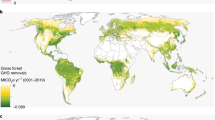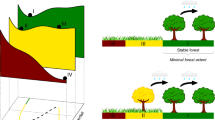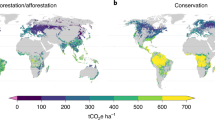Abstract
Tropical forests make an approximately neutral contribution to the global carbon cycle, with intact and recovering forests taking in as much carbon as is released through deforestation and degradation. In the near future, tropical forests are likely to become a carbon source, owing to continued forest loss and the effect of climate change on the ability of the remaining forests to capture excess atmospheric carbon dioxide. This will make it harder to limit global warming to below 2 °C. Encouragingly, recent international agreements commit to halting deforestation and degradation, but a lack of fundamental data for use in monitoring and model design makes policy action difficult.
This is a preview of subscription content, access via your institution
Access options
Access Nature and 54 other Nature Portfolio journals
Get Nature+, our best-value online-access subscription
$29.99 / 30 days
cancel any time
Subscribe to this journal
Receive 51 print issues and online access
$199.00 per year
only $3.90 per issue
Buy this article
- Purchase on Springer Link
- Instant access to full article PDF
Prices may be subject to local taxes which are calculated during checkout



Similar content being viewed by others
References
Le Quéré, C. et al. Global carbon budget 2016. Earth Syst. Sci. Data 8, 605–649 (2016).An annually produced analysis of the best evidence for the size and trends of the components of the global carbon cycle.
Tans, P. NOAA/ESRL https://www.esrl.noaa.gov/gmd/ccgg/trends/ (2017).
Keeling, R. Scripps Institution of Oceanography http://scrippsco2.ucsd.edu/ (2017).
Grace, J., Mitchard, E. & Gloor, E. Perturbations in the carbon budget of the tropics. Glob. Chang. Biol. 20, 3238–3255 (2014).
Schimel, D., Stephens, B. B. & Fisher, J. B. Effect of increasing CO2 on the terrestrial carbon cycle. Proc. Natl Acad. Sci. USA 112, 436–441 (2015).This study reconciles atmospheric inversions with models, and so confirms that there is a strong tropical carbon sink, driven by rising atmospheric CO 2.
Pan, Y. et al. A large and persistent carbon sink in the world’s forests. Science 333, 988–993 (2011).This paper combines evidence from thousands of global forest plots and other data to estimate the size and location of forest sinks and sources.
Patra, P. K. et al. The Orbiting Carbon Observatory (OCO-2) tracks 2–3 peta-gram increase in carbon release to the atmosphere during the 2014–2016 El Niño. Sci. Rep. 7, 13567 (2017).
Baccini, A. et al. Tropical forests are a net carbon source based on aboveground measurements of gain and loss. Science 358, 230–234 (2017).
Cox, P. M. et al. Sensitivity of tropical carbon to climate change constrained by carbon dioxide variability. Nature 494, 341–344 (2013).
Ma, X. et al. Drought rapidly diminishes the large net CO2 uptake in 2011 over semi-arid Australia. Sci. Rep. 6, 37747 (2016).
Liu, J., Bowman, K. W., Schimel, D. S., Parazoo, N. C., Jiang, Z., Lee, M. et al. Contrasting carbon cycle responses of the tropical continents to the 2015–2016 El Niño. Science 358, eaam5690 (2017).This study uses a satellite sensitive to atmospheric greenhouse gas concentrations to show that all tropical forest areas released CO 2 in response to the 2015–2016 El Niño, but for different reasons.
Poorter, L. et al. Biomass resilience of Neotropical secondary forests. Nature 530, 211–214 (2016).
Brienen, R. J. W. et al. Long-term decline of the Amazon carbon sink. Nature 519, 344–348 (2015). Long-term analysis of Amazon plot data shows that the intact forest sink is reducing in size.
Qie, L. et al. Long-term carbon sink in Borneo’s forests halted by drought and vulnerable to edge effects. Nat. Commun. 8, 1966 (2017); erratum 9, 342, (2018).
Peylin, P. et al. Global atmospheric carbon budget: results from an ensemble of atmospheric CO2 inversions. Biogeosciences 10, 6699–6720 (2013).
Stephens, B. B. et al. Weak northern and strong tropical land carbon uptake from vertical profiles of atmospheric CO2. Science 316, 1732–1735 (2007).
van der Werf, G. R. et al. CO2 emissions from forest loss. Nat. Geosci. 2, 737–738 (2009); erratum 2, 829 (2009).
Sitch, S. et al. Recent trends and drivers of regional sources and sinks of carbon dioxide. Biogeosciences 12, 653–679 (2015).
Ciais, P. et al. in Climate Change 2013: The Physical Science Basis, Contribution of Working Group I to the Fifth Assessment Report of the Intergovernmental Panel on Climate Change (eds Stocker, T. F. et al.) (Cambridge Univ. Press, 2013).
Hansen, M. C. et al. High-resolution global maps of 21st-century forest cover change. Science 342, 850–853 (2013).An important dataset is presented and analysed: global deforestation maps at 30-m resolution from 2000–2012.
Keenan, R. J. et al. Dynamics of global forest area: Results from the FAO Global Forest Resources Assessment 2015. For. Ecol. Manage. 352, 9–20 (2015).
Houghton, R. A., Byers, B. & Nassikas, A. A. A role for tropical forests in stabilizing atmospheric CO2. Nat. Clim. Chang. 5, 1022–1023 (2015).
Schleussner, C.-F. et al. Science and policy characteristics of the Paris Agreement temperature goal. Nat. Clim. Chang. 6, 827–835 (2016).
Saatchi, S. S. et al. Benchmark map of forest carbon stocks in tropical regions across three continents. Proc. Natl Acad. Sci. USA 108, 9899–9904 (2011).
Baccini, A. et al. Estimated carbon dioxide emissions from tropical deforestation improved by carbon-density maps. Nat. Clim. Chang. 2, 182–185 (2012).
Avitabile, V. et al. An integrated pan-tropical biomass map using multiple reference datasets. Glob. Chang. Biol. 22, 1406–1420 (2016).
Beer, C. et al. Terrestrial gross carbon dioxide uptake: global distribution and covariation with climate. Science 329, 834–838 (2010).
Malhi, Y. The productivity metabolism and carbon cycle of tropical forest vegetation. J. Ecol. 100, 65–75 (2012). This paper presents how tropical forests cycle carbon, and the physiological basis of how this will change with climate change.
Malhi, Y. The carbon balance of tropical forest regions 1990–2005. Curr. Opin. Environ. Sustain. 2, 237–244 (2010).
Smith, P. et al. in Climate Change 2014: Mitigation of Climate Change. Contribution of Working Group III to the Fifth Assessment Report of the Intergovernmental Panel on Climate Change (eds Edenhofer, O. et al.) (Cambridge Univ. Press, 2014).
Poulter, B. et al. Contribution of semi-arid ecosystems to interannual variability of the global carbon cycle. Nature 509, 600–603 (2014).
Jung, M. et al. Global patterns of land-atmosphere fluxes of carbon dioxide latent heat, and sensible heat derived from eddy covariance, satellite, and meteorological observations. J. Geophys. Res. 116, (2011).
Zarin, D. J. et al. Can carbon emissions from tropical deforestation drop by 50% in 5 years? Glob. Chang. Biol. 22, 1336–1347 (2016).
Achard, F. et al. Determination of tropical deforestation rates and related carbon losses from 1990 to 2010. Glob. Chang. Biol. 20, 2540–2554 (2014).
Houghton, R. A. et al. Carbon emissions from land use and land-cover change. Biogeosciences 9, 5125–5142 (2012).
Tyukavina, A. et al. Aboveground carbon loss in natural and managed tropical forests from 2000 to 2012. Environ. Res. Lett. 10, 074002 (2015).
Liu, Y. Y. et al. Recent reversal in loss of global terrestrial biomass. Nat. Clim. Chang. 5, 470–474 (2015).
Harris, N. L. et al. Baseline map of carbon emissions from deforestation in tropical regions. Science 336, 1573–1576 (2012).
Kim, D.-H., Sexton, J. O. & Townshend, J. R. Accelerated deforestation in the humid tropics from the 1990s to the 2000s. Geophys. Res. Lett. 42, 3495–3501 (2015).
Mitchard, E. T. A. et al. Markedly divergent estimates of Amazon forest carbon density from ground plots and satellites. Glob. Ecol. Biogeogr. 23, 935–946 (2014).
de Andrade, R. B. et al. Scenarios in tropical forest degradation: carbon stock trajectories for REDD+. Carbon Balance Manag. 12, 6 (2017).
Bustamante, M. M. C. et al. Toward an integrated monitoring framework to assess the effects of tropical forest degradation and recovery on carbon stocks and biodiversity. Glob. Chang. Biol. 22, 92–109 (2016).
Brinck, K. et al. High resolution analysis of tropical forest fragmentation and its impact on the global carbon cycle. Nat. Commun. 8, 14855 (2017).
Chaplin-Kramer, R. et al. Degradation in carbon stocks near tropical forest edges. Nat. Commun. 6, 10158 (2015).
Ryan, C. M., Berry, N. J. & Joshi, N. Quantifying the causes of deforestation and degradation and creating transparent REDD+ baselines: a method and case study from central Mozambique. Appl. Geogr. 53, 45–54 (2014).
Berenguer, E. et al. A large-scale field assessment of carbon stocks in human-modified tropical forests. Glob. Chang. Biol. 20, 3713–3726 (2014).
Meyer, V. et al. Detecting tropical forest biomass dynamics from repeated airborne lidar measurements. Biogeosciences 10, 5421–5438 (2013).
Global Forest Resources Assessment (FAO, 2015).
Dargie, G. C. et al. Age, extent and carbon storage of the central Congo Basin peatland complex. Nature 542, 86–90 (2017).
Draper, F. C. et al. The distribution and amount of carbon in the largest peatland complex in Amazonia. Environ. Res. Lett. 9, 124017 (2014).
Page, S. Rieley, J. O., Banks, C. J. Global and regional importance of the tropical peatland carbon pool. Glob. Chang. Biol. 17, 798–818 (2011).
Moore, S. et al. Deep instability of deforested tropical peatlands revealed by fluvial organic carbon fluxes. Nature 493, 660–663 (2013).
Hooijer, A. et al. Current and future CO2 emissions from drained peatlands in Southeast Asia. Biogeosciences 7, 1505–1514 (2010).
Page, S. E. et al. The amount of carbon released from peat and forest fires in Indonesia during 1997. Nature 420, 61–65 (2002).This study presents evidence that the peat fires in Indonesia during the 1997 El Niño event resulted in a globally important release of carbon.
Roucoux, K. H. et al. Threats to intact tropical peatlands and opportunities for their conservation. Conserv. Biol. 31, 1283–1292 (2017).
Bloom, A. A. et al. A global wetland methane emissions and uncertainty dataset for atmospheric chemical transport models (WetCHARTs version 1.0). Geosci. Model Dev. 10, 2141–2156 (2017).
Lewis, S. L. et al. Increasing carbon storage in intact African tropical forests. Nature 457, 1003–1006 (2009).
Phillips, O. L. et al. Changes in the carbon balance of tropical forests: evidence from long-term plots. Science 282, 439–442 (1998).
Sheil, D. A critique of permanent plot methods and analysis with examples from Budongo Forest Uganda. For. Ecol. Manage. 77, 11–34 (1995).
Wheeler, C. E. et al. Carbon sequestration and biodiversity following 18 years of active tropical forest restoration. For. Ecol. Manage. 373, 44–55 (2016).
Grainger, A. Difficulties in tracking the long-term global trend in tropical forest area. Proc. Natl Acad. Sci. USA 105, 818–823 (2008).
Romijn, E. et al. Assessing change in national forest monitoring capacities of 99 tropical countries. For. Ecol. Manage. 352, 109–123 (2015).
Moutinho, P., Guerra, R. & Azevedo-Ramos, C. Achieving zero deforestation in the Brazilian Amazon: What is missing? Elementa 4, 000125 (2016).
Butsic, V., Baumann, M., Shortland, A., Walker, S. & Kuemmerle, T. Conservation and conflict in the Democratic Republic of Congo: the impacts of warfare mining, and protected areas on deforestation. Biol. Conserv. 191, 266–273 (2015).
Milodowski, D. T., Mitchard, E. T. A. & Williams, M. Forest loss maps from regional satellite monitoring systematically underestimate deforestation in two rapidly changing parts of the Amazon. Environ. Res. Lett. 12, 094003 (2017).
Swamy, L., Drazen, E., Johnson, W. R. & Bukoski, J. J. The future of tropical forests under the United Nations Sustainable Development Goals. J. Sustain. For. 37, 221–256 (2018).
Meyfroidt, P. & Lambin, E. F. Forest transition in Vietnam and displacement of deforestation abroad. Proc. Natl Acad. Sci. USA 106, 16139–16144 (2009).
Sonter, L. J. et al. Mining drives extensive deforestation in the Brazilian Amazon. Nat. Commun. 8, 1013 (2017).
Bonner, M. T. L., Schmidt, S. & Shoo, L. P. A meta-analytical global comparison of aboveground biomass accumulation between tropical secondary forests and monoculture plantations. For. Ecol. Manage. 291, 73–86 (2013).
Boysen, L. R. et al. Global and regional effects of land-use change on climate in 21st century simulations with interactive carbon cycle. Earth Syst. Dyn. 5, 309–319 (2014).
Bonan, G. B., Doney, S. C. Climate ecosystems, and planetary futures: The challenge to predict life in Earth system models. Science 359, eaam8328 (2018). An introduction to ESMs, and how they can be improved.
Gibbs, H. K. et al. Tropical forests were the primary sources of new agricultural land in the 1980s and 1990s. Proc. Natl Acad. Sci. USA 107, 16732–16737 (2010).
Phillips, O. L. et al. Drought sensitivity of the Amazon rainforest. Science 323, 1344–1347 (2009).
Brando, P. M. et al. Abrupt increases in Amazonian tree mortality due to drought-fire interactions. Proc. Natl Acad. Sci. USA 111, 6347–6352 (2014).
Rowland, L. et al. Death from drought in tropical forests is triggered by hydraulics not carbon starvation. Nature 528, 119–122 (2015).
Betts, R. A. et al. Climate and land use change impacts on global terrestrial ecosystems and river flows in the HadGEM2-ES Earth system model using the representative concentration pathways. Biogeosciences 12, 1317–1338 (2015).
Ahlström, A., Schurgers, G., Arneth, A. & Smith, B. Robustness and uncertainty in terrestrial ecosystem carbon response to CMIP5 climate change projections. Environ. Res. Lett. 7, 044008 (2012).
Stouffer, R. J. et al. CMIP5 scientific gaps and recommendations for CMIP6. Bull. Am. Meteorol. Soc. 98, 95–105 (2017).
Moss, R. H. et al. The next generation of scenarios for climate change research and assessment. Nature 463, 747–756 (2010).
Ahlström, A., Xia, J., Arneth, A., Luo, Y. & Smith, B. Importance of vegetation dynamics for future terrestrial carbon cycling. Environ. Res. Lett. 10, 054019 (2015).
Paris Agreement, Article 5 (UNFCCC, 2015).
Turnhout, E. et al. Envisioning REDD+ in a post-Paris era: between evolving expectations and current practice. WIREs Clim. Chang. 8, e425 (2017).
Rossi, V. et al. Could REDD+ mechanisms induce logging companies to reduce forest degradation in Central Africa? J. For. Econ. 29, 107–117 (2017).
FORESTS: Action Statements and Action Plan (United Nations, 2014)
Transforming our world: the 2030 Agenda for Sustainable Development (United Nations, 2015).
Veldman, J. W., Silveira, F. A. O., Fleischman, F. D., Ascarrunz, N. L. & Durigan, G. Grassy biomes: an inconvenient reality for large-scale forest restoration? A comment on the essay by Chazdon and Laestadius. Am. J. Bot. 104, 649–651 (2017).
Latawiec, A. E., Strassburg, B. B. N., Brancalion, P. H. S., Rodrigues, R. R. & Gardner, T. Creating space for large-scale restoration in tropical agricultural landscapes. Front. Ecol. Environ. 13, 211–218 (2015).
Cavaleri, M. A., Reed, S. C., Smith, W. K. & Wood, T. E. Urgent need for warming experiments in tropical forests. Glob. Chang. Biol. 21, 2111–2121 (2015).
Chave, J. et al. Improved allometric models to estimate the aboveground biomass of tropical trees. Glob. Chang. Biol. 20, 3177–3190 (2014).
Doughty, C. E. et al. What controls variation in carbon use efficiency among Amazonian tropical forests? Biotropica 50, 16–25 (2018).
Nepstad, D. C., Tohver, I. M., Ray, D., Moutinho, P. & Cardinot, G. Mortality of large trees and lianas following experimental drought in an Amazon forest. Ecology 88, 2259–2269 (2007).
Acknowledgements
The author acknowledges partial support from the Natural Environment Research Council (grant NE/R000751/1) and the UK Space Agency (grant Forests 2020).
Reviewer information
Nature thanks P. Brando, J. Chave and Y. Malhi for their contribution to the peer review of this work.
Author information
Authors and Affiliations
Corresponding author
Ethics declarations
Competing interests
The authors declare no competing interests.
Additional information
Publisher’s note: Springer Nature remains neutral with regard to jurisdictional claims in published maps and institutional affiliations.
Rights and permissions
About this article
Cite this article
Mitchard, E.T.A. The tropical forest carbon cycle and climate change. Nature 559, 527–534 (2018). https://doi.org/10.1038/s41586-018-0300-2
Received:
Accepted:
Published:
Issue Date:
DOI: https://doi.org/10.1038/s41586-018-0300-2
This article is cited by
-
Monitoring Earth’s climate variables with satellite laser altimetry
Nature Reviews Earth & Environment (2024)
-
Transition from positive to negative indirect CO2 effects on the vegetation carbon uptake
Nature Communications (2024)
-
A new circa 2007 biomass map for China differs significantly from existing maps
Scientific Data (2024)
-
Elevated CO2 levels promote both carbon and nitrogen cycling in global forests
Nature Climate Change (2024)
-
Carbon sink response of terrestrial vegetation ecosystems in the Yangtze River Delta and its driving mechanism
Journal of Geographical Sciences (2024)
Comments
By submitting a comment you agree to abide by our Terms and Community Guidelines. If you find something abusive or that does not comply with our terms or guidelines please flag it as inappropriate.



